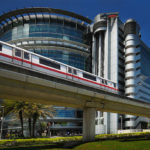Recent Posts by Holger
According to the United Nations World Urbanization Prospects, cities will add over 2.5 billion people in the next 40 years, with 90% of this growth coming from cities in emerging economies. China and India alone are expected to add 276 million and 218 million urban ...

Tuesday’s U.N. Climate Summit included unprecedented focus on cities and the transport sector at climate change conferences. City leaders committed to new actions to promote sustainable urban development and low carbon transport systems. Notable leaders at the Summit included Seoul Mayor ...

City leaders have a key role to play at next week’s UN Climate Summit in New York City, which brings together heads of state, mayors, business leaders, and civil society representatives to build momentum towards an international agenda to tackle ...

Holger Dalkmann, Director of EMBARQ – the producer of TheCityFix – wrote about the importance of developed and emerging cities improving sustainable transport in the 2014 Commonwealth Ministers Reference Book. Read his thoughts on growing trends contributing to sustainable cities worldwide. ...

This is the tenth and final post of the “Sustainable Urban Transport On The Move” blog series, exclusive to TheCityFix. Preparation of this series was possible thanks to a grant by Shell Corporation. Its contents are the sole responsibility of ...

More than 70 percent of the world’s population will live in cities by 2050. So cities represent the single greatest opportunity for targeted, meaningful actions that create impact on the ground, improve the quality of life for billions of people, and reduce ...

Human society has a lot riding on the transport sector. Safe, efficient, and sustainable transport not only has the potential to enhance or degrade the public spaces, health, and economic dynamism of where the majority of humanity lives – in ...

The world is in the midst of unprecedented urbanization, with cities expected to hold 5.2 billion residents by 2050. One of the major challenges of the 21st century, therefore, is achieving a sustainable future for our cities. And transport – ...

Cities are the world’s engines of economic growth. Yet many have a long way to go when it comes to ensuring safe and affordable access to jobs, education, and healthcare for its citizens — in part because their transport systems ...

“It is not possible to effectively address climate change without substantive [greenhouse gas] GHG emission reductions by the transport sector. Climate action on transport is directly linked to sustainable development.” This statement is the founding principle of the Partnership on ...

The world, and Asia in particular, is heading in the wrong direction Asia is rapidly urbanizing, creating localized stress on the transport system. In 2011, for the first time in history, more Chinese lived in urban centers than rural areas ...

By Holger Dalkmann and Ashwin Prabhu — this post also appears in WRI Insights Indian cities are urbanizing at an unprecedented scale and pace. Over the next few decades, India’s urban population is expected to increase significantly, from 377 million in 2011 ...

This post was initially published on National Geographic City Solutions’ blog. City leaders face incredible pressure to deliver sustainable transportation. Cities now account for more than half of the world’s population—by 2050, they will hold 75 percent of us. These ...

The need for action on sustainable transport has never been more apparent than it is today. The world’s population is expected to reach a whopping 9.8 billion people by 2050, with about 70 percentof these people residing in cities. Meanwhile, greenhouse gas ...

“We cannot continue as we are,” echoed the participants at the Asian Development Bank (ADB) Transport Forum 2012 held in Manila earlier this month. Demographic trends around the world indicate that 44 million people will move to cities every year. ...

 Phil
Great article! A lot of what I have read here, has already been implemented in cities in the Netherlands, with Denmark the two bicycle countries par...
Phil
Great article! A lot of what I have read here, has already been implemented in cities in the Netherlands, with Denmark the two bicycle countries par...
 Bobby Salvin
I understand why some people wish mobility and GDP weren't connected, but it's wishful thinking. During the pandemic, for instance, when the economy...
Bobby Salvin
I understand why some people wish mobility and GDP weren't connected, but it's wishful thinking. During the pandemic, for instance, when the economy...
 Peace
Let me understand your Position -
We need to make our streets and public spaces dangerous and inhospitable so the disabled and infirm are forced to...
Peace
Let me understand your Position -
We need to make our streets and public spaces dangerous and inhospitable so the disabled and infirm are forced to...





















